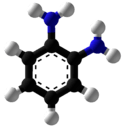''o''-Phenylenediamine
 | |||
| |||
| Names | |||
|---|---|---|---|
| Preferred IUPAC name
Benzene-1,2-diamine | |||
| Other names
o-Phenylene diamine 1,2-Diaminobenzene 1,2-Phenylenediamine | |||
| Identifiers | |||
3D model (JSmol) |
|||
| ChEBI | |||
| ChEMBL | |||
| ChemSpider | |||
| ECHA InfoCard | 100.002.210 | ||
| UNII | |||
| |||
| |||
| Properties | |||
| C6H8N2 | |||
| Molar mass | 108.14 g·mol−1 | ||
| Density | 1.031 g/cm3 | ||
| Melting point | 102 to 104 °C (216 to 219 °F; 375 to 377 K) | ||
| Boiling point | 252 °C (486 °F; 525 K) Other sources: 256 to 258 °C (493 to 496 °F; 529 to 531 K) | ||
| soluble in hot water | |||
| Acidity (pKa) | 0.80[2]
pka2 = 4.57 [2] | ||
| -71.98·10−6 cm3/mol | |||
| Hazards | |||
| Safety data sheet | Oxford MSDS | ||
EU classification (DSD) (outdated) |
Toxic (T); Dangerous for the environment (N) | ||
| NFPA 704 | |||
Except where otherwise noted, data are given for materials in their standard state (at 25 °C [77 °F], 100 kPa). | |||
| Infobox references | |||
o-Phenylenediamine (OPD) is an organic compound with the formula C6H4(NH2)2. This aromatic diamine is an important precursor to many heterocyclic compounds. It is isomeric with m-phenylenediamine and p-phenylenediamine.
Preparation
Commonly, 2-nitrochlorobenzene is treated with ammonia and the resulting 2-aminonitrobenzene is then hydrogenated:[3]
- ClC6H4NO2 + 2 NH3 → H2NC6H4NO2 + NH4Cl
- H2NC6H4NO2 + 3 H2 → H2NC6H4NH2 + 2 H2O
In the laboratory, the reduction of the nitroaniline is effected with zinc powder in ethanol, followed by purification of the diamine as the hydrochloride salt.[4] This compound darkens in air; impurities may be removed by treating a hot aqueous solution with sodium dithionite (reducing agent) and activated carbon, and allowing the product to cool crystallize.
Reactions and uses
o-Phenylenediamine condenses with ketones and aldehydes to give rise to a variety of useful products. Reactions with carboxylic acids and their derivatives afford benzimidazoles. The herbicide benomyl is prepared in this manner. Also, quinoxalinedione may be prepared by condensation of o-phenylenediamine with dimethyl oxalate. Condensation with xanthate esters affords mercaptoimidazoles, which are used as antioxidants in rubber products. Treatment with nitrous acid gives benzotriazole, a corrosion inhibitor. Condensation of substituted o-phenylenediamine with various diketones is used in the preparation of a variety of pharmaceuticals.[5]
In coordination chemistry, phenylenediamine is an important ligand precursor. Schiff base derivatives, such as those derived from salicylaldehyde, are excellent chelating ligands. Oxidation of its metal-phenylenediamine complexes affords the diimine derivatives, which are intensely colored and often exist in multiple stable oxidation states.[6]
Safety
With an LD50 of 44 mg/L (aquatic), o-phenylenediamine is about 1000 times less toxic than the para-isomer. Anilines are typically handled as if they are carcinogenic. For many applications, OPD has been replaced by safer alternatives such as 3,3',5,5'-tetramethylbenzidine.[7]
References
- ↑ DuPont Specialty Intermediates: o-Phenylenediamine (OPD)
- 1 2 http://www.phs.d211.org/science/smithcw/AP%20Chemistry/Posted%20Tables/Acid%20Dissociations.pdf
- ↑ Robert A. Smiley "Phenylene- and Toluenediamines" in Ullmann's Encyclopedia of Industrial Chemistry 2002, Wiley-VCH, Weinheim. doi:10.1002/14356007.a19_405
- ↑ E. L. Martin (1943). "o-Phenylenediamine". Organic Syntheses. ; Collective Volume, 2, p. 501
- ↑ See for example, Renault, J.; et al. (1981). "Heterocyclic quinones. Quinoxaline-5,6 and 5,8 diones, potential antitumoral agents". Eur. J. Med. Chem. 16: 545–550.
- ↑ Warren, L. F. (1977). "Synthesis of [M'-N4] and [M'-N6] Complexes Based on o-Benzoquinone Diimine with Cobalt, Iron, and Ruthenium". Inorg. Chem. 16 (11): 2814–2819. doi:10.1021/ic50177a028.
- ↑ Deshpande SS (1996). Enzyme Immunoassays: From Concept to Product Development. New York: Chapman & Hall. p. 169. ISBN 978-0-412-05601-7.


